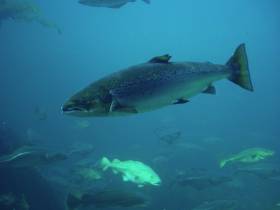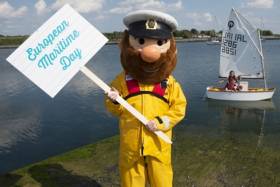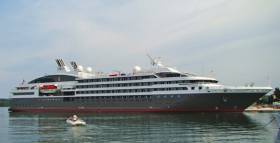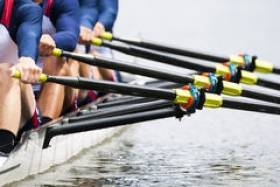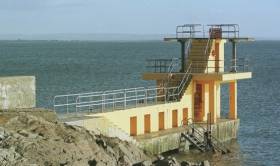Displaying items by tag: Galway
Mayo Man Convicted Over Unlawfully Caught Salmon
#Angling - A Mayo man was charged with possession of eight unlawfully caught salmon at Lacken Pier on 22 July 2015 at a sitting of Ballina District Court earlier this month.
Stephen Rooney of Ballina, Co Mayo pleaded guilty to the charge and was fined €160 with costs amounting to €250.
Judge John Lindsay heard evidence that fishery officers had observed a car on Lacken Pier on the night of 21st July 2015. The officers noticed liquid oozing from the underside of the car, which they suspected to be blood and mucous from fish.
The car was kept under observation overnight, and in the morning several attempts were made to contact Rooney, its owner. The car was searched when he failed to respond, and eight fresh net-marked salmon and an undersized lobster were found in the boot.
Commenting on the case, Inland Fisheries Ireland (IFI) chief executive Dr Ciaran Byrne said: “Netting of salmon in the open sea has been illegal since 2007 as it is indiscriminate and takes fish destined for different river systems, some of which have depleted salmon stocks and are under severe pressure.
“Salmon angling is extremely valuable to the tourism industry in North Mayo and provides revenue, employment to local communities, and recreation to thousands of anglers both local and visiting from abroad and other parts of Ireland. Inland Fisheries Ireland will continue to work to protect this resource for the good of the community.”
Elsewhere, at sitting of Galway District Court on 7 June, Judge John King convicted two Galway fishermen of the non-payment of fines issued by fishery officers, and ordered a third man to pay a donation on the same charge.
Leslie Sammon, with an address at Ballinasloe, Co Galway, was before the court over non-payment of a fixed penalty notice of €150 for failing to complete a logbook upon taking a salmon from the Clare River, Claregalway last July. He was ordered to pay €200 to the RNLI by Judge King, who agreed to a donation in lieu of a conviction.
Alekseys Minkevics, with an address at Knocknacarra, Co Galway, was also summonsed in connection with an incident on the Clare River on 30 September last.
Minkevics, who failed to appear in court, had been observed fishing with live perch, in breach of fisheries legislation, and failed to pay the fine within the required timeframe.
Judge King convicted Minkevics and ordered him to pay €300, as well as €600 in costs. His fishing equipment was also ordered to be forfeited.
Viktor Buss, with an address at Headford Road, Galway was charged with a breach of a coarse fish byelaw on 5 October when he was found in possession of 32 coarse fish, eight times the legal limit. He was issued with a fixed penalty notice of €150 which he failed to pay.
Judge King recorded a conviction against Buss, who did not appear in court, and issued a fine of €300 with costs amounting to €600. His fishing equipment was also forfeited.
IFI has a confidential hotline number to enable members of the general public to report incidents - 1890 34 74 24 or 1890 FISH 24. This phone line is designed to encourage the reporting of incidents of illegal fishing, water pollution and invasive species.
SeaFest Sails into Galway
Prepare to ‘sea’ it all in Galway over the first weekend in July as the city welcomes SeaFest maritime festival, and plunges into a weekend of ocean-themed activities and entertainment.
A key goal of ‘Harnessing our Ocean Wealth: An Integrated Marine plan for Ireland’, SeaFest is all about increasing participation and engagement with the sea, showcasing Ireland’s abundant maritime resources and celebrating its proud maritime heritage – but there’ll be plenty of light-hearted fun too.
Preparing to sail his quirky craft straight into maritime history will be artist Frank Bôlter. His ‘On A Voyage’ project is a whimsical, epic and heroic attempt to build and sail a giant paper boat which he has made with members of the Kinvara Sailing Club.
The craft is a grown-up, giant-scale and, hopefully, seaworthy, version of the traditional folded paper yachts made by children. Despite its unlikely appearance, crew confidence in its reliability is high, for Frank has travelled the world with his project creating giant paper boats in Europe and Sri Lanka. Here in Galway, ‘On A Voyage’ is a pilot programme within the Galway 2020 project ‘Every Place’, a project devised by Neil Butler, Artistic Director of UZ Arts, and produced in partnership with TULCA for Galway 2020.
The giant paper boat will be launched at Kinvara Pier on Saturday 2 July at 12noon and will sail proudly into Galway Harbour alongside a flotilla of Galway Hookers. Always a favourite with locals and visitors alike, the Hookers will be showing off their speed and style with a series of races including the chase for the historic Galway Plate.
When you’ve done your share of cheering from the shoreline, there will also be opportunities to step on board craft which are usually closed to the public. Tours are free of charge but capacity will be limited.
The 15m survey catamaran, The RV Keary, will be berthed in Galway docks throughout SeaFest. With an open invitation to step on board, visit to see how and where seabed data is acquired and gain an insight into the work of marine surveyors. The aluminium boat is crewed by scientists from the Marine Institute and the Geological Survey of Ireland as part of the joint seabed mapping project – INFOMAR. Equipped with state of the art sonar mapping systems as well as seabed sampling capabilities, The RV Keary works mostly in inshore waters which can be as shallow as 2 metres. The vessel has also played its part in charting our maritime history, hosting archaeological dives on historical wrecks around the coast.
The Commissioner of Irish Lights, who maintain all the lighthouses across the country, will be bringing their exhibition of the role of Irish lighthouses from 1911 to 1923 and their own ship, The Granuaile, to SeaFest, providing a unique opportunity to see on board one of the most advanced marine vessels of its kind in the world.
Both of the Marine Institute’s (Foras Na Mara) Research Vessels, the Celtic Explorer and the Celtic Voyager will also dock at Galway, with the Celtic Explorer conducting hourly open house tours throughout the festival weekend. The national research vessels will be a familiar sight to many locals as Galway Harbour is their home port between surveys which include fish stock assessments, mapping Ireland’s seabed, surveying deep sea habitats, and oceanographic research, including the survey of the Whittard Canyon system with NUIG scientists earlier this month. The 65m RV Celtic Explorer can accommodate up to 35 personnel including crew and scientists and can spend 35 consecutive days at sea. The 31.5 m RV Celtic Voyager will also be open to the public. The Marine Institute’s unmanned submarine, the ROV Holland I will be on display alongside the research vessels. It’s normally deployed from the deck of the RV Celtic Explorer and piloted remotely to capture high definition video footage of the deep ocean as well as collecting samples from the seabed.
Adding drama to the line-up of vessels in port will be the naval service ship, L.É. Niamh. She is built to the successful RóisÁn design which optimises her year-round patrol performance in Irish waters which are among the roughest in the world. For that reason L.É. Niamh has a greater length overall (78.8m), giving the ship a long sleek appearance.
If its appearance is dramatic then so too are the roles of the vessel and its ship’s company. During a 10-week mission to the Mediterranean late last year 2015 the L.É. Niamh crew delivered a baby, named Destiny, rescued more than 4,100 people at sea and had to recover 39 bodies in the course of tasks requested by the Italian Maritime Rescue Co-ordination Centre.
If you’re tempted to have a go on the water, then try Tri Sailing. A 20 foot keelboat (also known as a Sonar), will be close by the Tri Sailing promotional stand in the Inner Harbour, ready to give experiential trips for up to five people at a time. Demand is sure to be high, but the experience promises to be well worth a wait – especially as the Inner Harbour area will be packed with entertainment.
If you’d prefer to keep your feet on dry land while you gain your maritime experience, then what about captaining a remote control boat? There will be five fabulous model craft doing duty at the weekend at the Inner Harbour, with experts on hand to help ‘newbies’ get to grips with the complexities of steering and manoeuvring the mini-vessels.
As any seafarer will confirm, the sea demands our respect, with safety always the key priority. The RNLI will reinforce that message with their engaging Respect the Water Campaign Roadshow and a packed programme of activities both on and off the water, including an awe-inspiring Air/Sea Rescue demonstration staged in collaboration with the Coast Guard and RNLI on Saturday 2 July, starting at 2.30pm.
To see the full SeaFest programme and check out ‘On The Water’ events visit www.seafest.ie.
See It All At Second Annual SeaFest This July
#SeaFest - A wave of excitement is about to break over Galway as the city prepares to host SeaFest, Ireland's national maritime festival, docking in the city over the action-packed weekend of Saturday 2 and Sunday 3 July.
Following a successful inaugural event in Cork last year, SeaFest is now firmly established as an annual celebration of all things nautical, honouring Ireland's multi-faceted relationship with the sea.
Launching the packed programme for Galway, new Marine Minister Michael Creed said: "SeaFest is all about raising our awareness of the value and opportunities provided by the sea, giving locals and visitors alike fresh opportunities to engage in sea-themed events and activities.
"We're making a splash with a programme of events which will include an array of seafaring family fun, on the water activities plus a seafood fair packed with great natural produce and cookery demonstrations by celebrity chefs.
"We'll be hosting tours of ocean-going vessels; offering new opportunities to get afloat on leisure craft and boats, showcasing exhibits on marine life and creatures of the deep and providing all manner of festival fun and entertainment for all the family.
"Importantly, we're proud to be playing our part in the wider Harnessing Our Ocean Wealth initiative, providing opportunities for people of every age and interest to deepen their knowledge and appreciation of the ocean, building on how we can each act to protect our abundant maritime resources."
The SeaFest programme will run from 9am to 6pm daily with Galway Harbour providing a focal point of activity.
All things fishy will be celebrated at the festival's BIM/Bord Bia Sea Food Extravangza, located in a Big Top marquee at The Docks. Here celebrity chefs Martin Shanahan and Rory O'Connell will be rolling out recipes and cookery demos to tempt seafood lovers' tastebuds, while Michael O'Meara from Oscar's Bistro in Galway and the author of the top-selling Sea Gastronomy (nominated for Best Cookbook in the World) will also share his knowledge and favourite dishes.
BIM's 2015 Young Fishmonger Of The Year, Gerard Collier from The Fisherman's Catch in Clogherhead, Co Louth will take the mystery out of preparing fish and shellfish at home. Visitors will also get to taste the best of Irish seafood from some of Ireland's best seafood producers.
The inner pier at Galway Harbour is where you will find ship tours, free screenings of Jean Michel Cousteau's film Secret Ocean (see HERE for tickets) and 'Beneath Our Wild Atlantic', an exciting, new, interactive, family-friendly exhibition from the Marine Institute.
Linking the Big Top and Inner Harbour will be a linear quayside Festival Village, a mini market of crafts and culinary temptation, all served up with nautical style and relaxed entertainment, and complemented with regular personal appearances by the RNLI's Stormy Stan character.
Intrepid SeaFesters will have the opportunity to get up close and personal with a range of vessels, invited to hop on board for show-and-tell tours.
The Marine Institute's research vessels, the Celtic Explorer and the Celtic Voyager, will be conducting open house tours of the ships over the festival. The Commissioner of Irish Lights, responsible for lighthouses right around the country, will be bringing its own ship, the Granuaile, into the harbour and will present a 'Safety at Sea Through War and Upheaval' exhibition from Irish Lights and the Royal Irish Academy, on the role of Irish lighthouses in the period 1911-1923.
'On A Voyage' will be a chance to watch on in awe as Frank Bölter sails an extraordinary large scale origami paper boat. This unusual sailing craft is made out of giant sheets of folded paper using origami techniques and reinforced with metal poles.
Enthusiasts of the traditional sailing won't be disappointed, with a gathering of Galway Hookers in the harbour, and a day of racing culminating in the challenge for the historic Galway Plate.
Underpinning the fun of SeaFest will be a serious four-day focus on research and the marine economy with a number of marine-related business and research events taking place around the city starting Thursday 30 June, each seeking to explore and strengthen the maritime heritage, economy and identity.
The third annual Our Ocean Wealth Conference will feature a number of sessions where speakers and delegates can delve more deeply into the conference theme of 'Innovating for our Marine Future'.
To whet the appetite, 'The Longest River' will be performed at St Augustinian Church (Middle Street) on Wednesday 29 June at 7pm. The performance will provide an opportunity to reflect on our maritime history and the opportunities ahead for mankind and our relationships with the earth, ocean and seas.
Visit SeaFest's 'What's On' page for the latest details as they are added to the event's programme of free activities, times and locations. Join in the fun on Facebook or follow SeaFest on Twitter.
SeaFest is supported by the Port of Galway, National University of Ireland, Galway, Department of Defence and Irish Coast Guard.
Luxury Mega-Yacht Is Galway's First Cruise Call Of 2016
#CruiseLiners - Galway welcomed its first cruise liner call of 2016 last weekend in the shape of the 'luxury mega-yacht' L'Austral, as the Connacht Tribune reports.
Though the vessel only stopped for a day, its 400 passengers and crew made the most of their visit, with sightseeing in the city and a tours to the Burren Kylemore Abbey among their options.
L'Austral's subsequent port of call is Cobh this Sunday (15 May), while Galway's next visitor is as soon as tomorrow (Saturday 14 May) when the Azores calls on the City of the Tribes.
That's one of six remaining cruise calls for Galway in the 2016 season, with Bremen on 11 June, Astor on 10 July, the Pacific Princess and Albatross on 2 and 8 August respectively, and the Prinsendam on 2 September all set to follow.
Inishbofin Ecotourism Award First For Irish Islands
#Inishbofin - Inishbofin has become the first Irish island to be recognised for its sustainable tourism efforts in an international awards scheme.
As The Irish Times reports, a number of the Connemara island's residents and local organisations will share in the Ecotourism award sanctioned by the Global Sustainable Tourism Council.
Angling, sailing and stand-up paddle boarding are some of the aquatic activities that helped clinch the accolade that's already gone to sustainable seaside attractions in Spiddal and Clifden.
In other news, county councillors are mooting a programme of safety works on slipways across Galway, according to Galway Bay FM.
The move follows the controversial restriction of access to the slipway at Galway Docks last month in the wake of the Buncrana tragedy in March.
'Pint Of Science' Marine Science Pub Talks In Galway Next Month
#MarineScience - Galway's Oslo Bar will host an evening of marine science talks on Tuesday 24 May as art of the international Pint of Science festival.
Taking place simultaneously over three evenings in May in Ireland, the UK, France, Italy, Spain, Germany, Austria, Canada, the USA, Brazil, Australia and South Africa, Pint of Science aims to encourage engagement with science beyond the lab or the lecture hall in the more approachable environment of a local pub.
The Oslo Bar in Galway city centre will host two evenings, one on the science of the human body on Monday 23 May, and a series of marine science topics from 7.30pm on Tuesday 24 May, MCed by Dr Nóirín Burke of the Galway Atlantaquaria.
Niall Keogh of GMIT will discuss the seabirds and cetaceans that populate Ireland's offshore waters, and Raissa Hogan of NUI Galway celebrates the diversity of Irish cold-water corals.
Representing INFOMAR and the Marine Institute, Oisín McManus will talk mapping the mountainous terrain that lies beneath the waves around Ireland, while Dr Tríona McGrath broaches the serious subject of ocean acidification.
For ticket information see the Pint of Science website HERE.
Galway Blocks Docks Slipway After Buncrana Tragedy
#Galway - Galway Harbour Company has blocked open access to a slipway in Galway Docks weeks after the Buncrana tragedy, as the Connacht Tribune reports.
The move was made a month after five members of the same family, including three children, died after their car slipped into Lough Swilly from the open slipway at Buncrana, Co Donegal on Sunday 20 March.
Galway's docks slipway had been used freely by recreational boaters – but as of last Thursday (21 April) local sailing clubs have been informed that the slipway can only be used with permission.
Access times have also been restricted to 9am-5pm on weekdays and by appointment on Saturdays in what the harbour company says is a move to avoid "risk to life".
But one local user has branded the locking-up of the slipway as "ridiculous" and said "there should have been a more measured response and consultation".
The Connacht Tribune has much more on the story HERE.
St Joseph's of Galway Trophy Winners at Schools' Championships
#Rowing: The Victor Ludorum Trophy for best school was won by St Joseph’s of Galway at the Irish Schools’ Championships at O’Brien’s Bridge in Clare today. Daire Lynch of Clonmel CBS was the best single sculler. Methodist College, Belfast, won the women’s under-23 eight.
Liferaft Won't Be Part Of Blackrock Tower Upgrades
#Galway - The liferaft at Blackrock Diving Tower on Galway Bay is not likely to be reinstated, as Galway Bay FM reports.
Concerns over risks posed by the raft were reiterated at a meeting of Galway City Council earlier this week, following a poor health and safety assessment of the amenity last year.
The raft was removed from the tower in 2014 after it was associated with incidents of falls and near drownings recorded by lifeguards, according to the Connacht Tribune.
Afloat.ie reported late last month on a public consultation regarding long-awaited upgrades and repairs to the iconic diving tower in Salthill.
Bodies Recovered From Galway Waters In Search For Missing Men
#Galway - BreakingNews.ie reports that post-mortems on two bodies recovered from Galway waters over the weekend are scheduled for today (Monday 18 April).
Gardaí have confirmed that the body of soldier Private Ben Garrett (21), who was missing since 31 March, was recovered from Galway Docks on Sunday morning (17 April).
Another body was found in Galway Bay on Saturday morning (16 April) in the search for Anthony Henehan, last seen entering the water at Wolfe Tone Bridge in Galway city on 10 March.



























